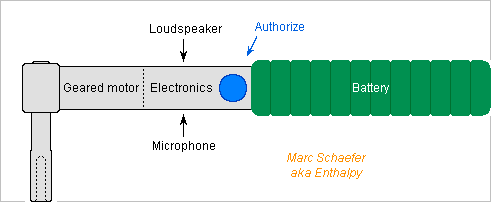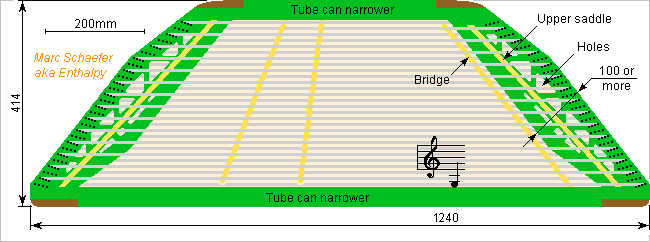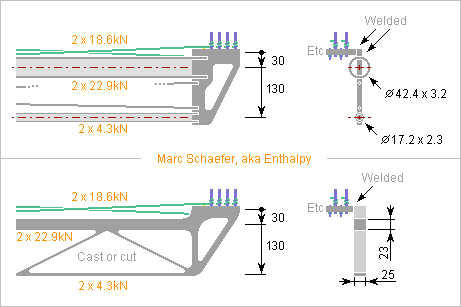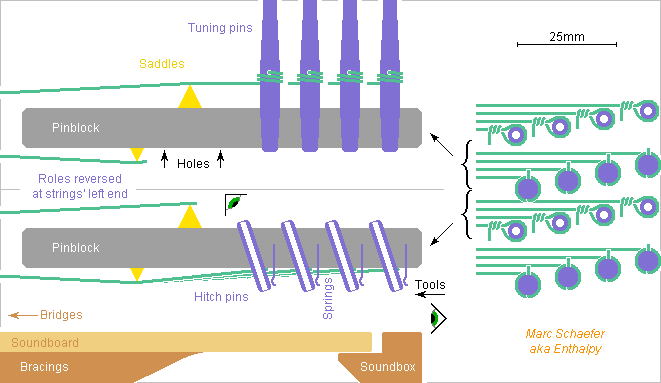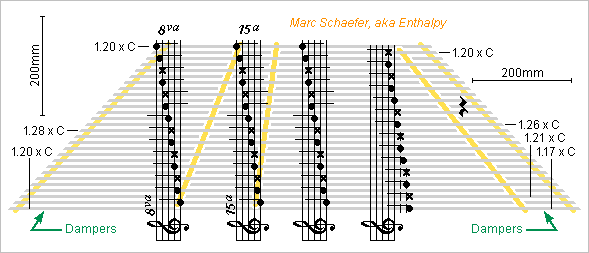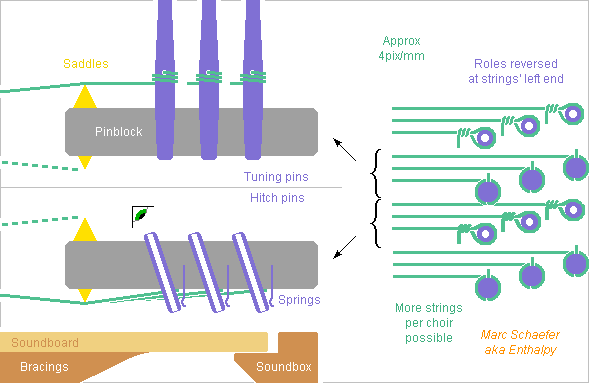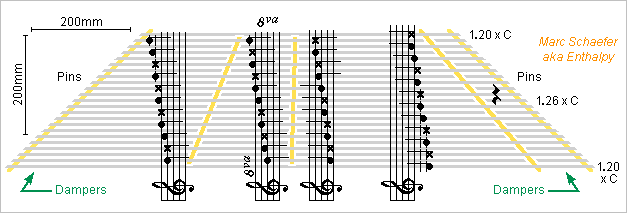-
Posts
3887 -
Joined
-
Last visited
-
Days Won
1
Content Type
Profiles
Forums
Events
Everything posted by Enthalpy
-
The piccolo oboe is also called oboe musette. Marigaux doesn't mention it any more in its production, so I've seen it only at loree-paris.com and patricola.com and while the Lorée model transposes in F a fourth higher and starts at written Bb, the Patricola transposes in Eb a minor third higher and starts at written B, how convenient. And here's one (1) record, little to make an idea of the sound: DjE7ESvl0f8 Logically, it should be worse than a soprano oboe for the necessary pressure, the lip pain, the intonation.
-
The oboe d'amore sounds three semitones lower than the usual soprano, transcribing in A. It was more common at the time of Bach or Telemann, but for instance Ravel wrote for its distinctive sound, and many luthiers propose it. The bulb smaller than at the English horn gives it a less heavy resonance, and depending on the musician, the sound may become a bit grainy, but typically less so than on the English horn, or not at all. 0UM0IJ9H360 instrument begins at 1:05 wruqhsb_12M begins 0:38 -Ts3N9BndA4 begins 0:17 tDMWNfYuWrs begins 1:36 1P9iEpOhCnQ begins 0:15 Elegant, isn't it?
-

Neanderthals Built a Water Reservoir
Enthalpy replied to Enthalpy's topic in Evolution, Morphology and Exobiology
Here some Youtube videos, all lengthy and in French, but less arid than science publications and with informative images: UpJ9bArJSXA by Arte, not found in German, many images on the site. HcyPmCqupi0 conference by Jacques Jaubert filmed in October 2016, Bruniquel begins at 0h30. Proposes water storage at 1h12min37s. bXYjc62X0n4 uploaded on May 27, 2016 tells "resembles a dam" at 01min30 but "go deep in cave not for dietary reasons but for religion" at 06min41 . The construction resembles so much a dam that it still retains water. 0JP0NqSXZSw Sophie Verheyden explains the context and logic, especially the dating. The team's preferred explanation for the fires is lighting, which must be obvious to anyone going to caves. They experimented that fat in bones burns once a wood fire has heated it, and it gives a clear and stable flame with less fumes, better than wood does. I wonder if a wick in fat avoids the wood phase as it does with oil. But a wick doesn't explain the clear effects of heat observed at the stalagmites. -
Harpists have 47 strings to retune often, cimbalists sometimes neglect to tune their 137, and zithers don't help their musician neither. Metal frames will stabilize the tuning, but only in the future and for metal strings. So could something help tuning these instruments? Maybe a motorised tuning hammer (which is a wrench) would. It would listen to the played string, determine the correction, and apply it up to perfect tune, taking the chosen pitch into account. I've seen tuning forks that indicate the necessary correction, but applying it autonomously seems uncommon or inexistent. Here an example of shape, others are possible, like a T more common at cimbaloms. Achieving perfect tune within one decay time would save much time. For high notes, the tool must be smart enough to work on repeated pluckings. ========== Safety demands error-free operation. Many strings are a tone or semitone short of breaking, and their debris are badly dangerous for the user and the instrument. Tuning a harp a bit too high explodes its soundboard. Perhaps the safest way is when each tuning pin of the instrument tells the hammer what note is correct. If the hammer can read, it suffices to engrave near the tuning pin a barcode or number, like Yamaha's note number. Or like did old low-tech reliable access control cards, each tuning pin could have a unique set of passive resonating circuits whose frequency the hammer senses by contact to obtain for instance a note name and octave number. One componentless printed circuit board can bear pairs of resonating circuits, say around 40.68MHz, for a dozen tuning pins or more. A current return path isn't mandatory. Multiple strings in a choir could share the resonators. May I please express the wish that manufacturers follow a single standard, and don't reproduce the present mess of octave numbering? Without additions to the instrument, the hammer could listen to the played string and emit a sound at the height it supposes correct. Only if the user confirms, would the hammer turn the tuning pin. I emphasize that identifying the height of a played string is difficult. A harp or grand cimbalom have a wide height range. To perceive the played string longer, the hammer must accept a big dynamic range. Though, many electronic tuners don't identify properly notes played by a piano. The hammer must make more checks, especially whether the undertaken action has the expected effect on the heard note. ========== The instrument could incorporate an actuator per string. Useless at a piano, useful to few people at a guitar, too expensive for a zither or hammered dulcimer, but for a harp it's conceivable, and extremely profitable for professionals. Share the electronics, put one geared motor per string. At 47 strings *20€ it's affordable, and one microphone or accelerometer per string is cheap. At least, each motor corresponds to one note without confusion. A harp could even tune itself while played, when a pedal is in flat position. Don't forget to make jokes at other instruments. Flip a switch, strike a proooooiiing, the harp is tuned, life is nicer. Marc Schaefer, aka Enthalpy
-
Thoughts about a soundbox for the Hackbrett suggested here on July 23, 2019. At its lowest note, G=197Hz, lambda/2=0.87m in air resembles the mean dimensions 0.8m*0.4m, so the radiation resistance would be roughly 5.6mohm*F2 = 217ohm if the soundboard moved uniformly. 1m/s rms (arbitrary for comparisons) would displace 0.30m3/s rms and radiate 20W. A mean 0.82m*0.37m soundbox 0.1m deep would provide 31dm3 and 0.22µF or j0.27mS at 197Hz. The same 0.30m3/s rms create 1.1kPa rms in the box whose 0.84m2 dissipate 6*10-9*SP2F0.5 = 89mW by conduction. Radiation is stronger even if multipolar and inefficient, so conduction losses need no deep box at this big soprano. The unstressed soundboard of Picea abies (Norway spruce) weighs some 1.7kg with bracings, bridges and strings: the 0.30m2 piston has 19H inductance. Take a Helmholtz resonance at B=248Hz with holes. The soundbox 0.1m deep for the frame suffices for Helmholtz: its 0.22µF need 1.9H of which the holes provide 2.1H and pass most throughput, good. If located between the soundboard and the box' walls, the metal frame would leave 2mm*(0.6m+1.0m) = 32cm2clearance around the soundboard. 6mm thickness make 2.3H leak, achieving the Helmholtz resonance without added hole. For 1m3/s rms throughput (arbitrary for comparisons), 313m/s at the slit dissipate 2.2*10-3*SV2F0,5 = 65W, so Q=55 at the resonance. This is decent as more losses add. The slit's width and height adjust L and Q, probably too variable and unstable. Alternately, the metal frame with some façade can surround the contiguous soundbox at front and aft for easier assembly. The soundboard can still have slits there, or better reach all walls. Then 770 holes, D=2mm h=3mm, achieve reliably the 2.0H with Q=28. That's one or several rosaces, where the hole or slit width adjusts Q. A CNC laser or milling machine does it better. The instrument's front panel can accommodate them. To make an idea of the table's data, I tuned resonant frequencies with a spreadsheet HackbrettBracings.xls based on unjustified and bizarre assumptions: Only the table vibrates. Lowest resonance at F#=372Hz, a fifth above Helmholtz. Next resonances rather close. Picea abies for the plate and the bracings in both directions. Rectangular table in the computations, 0.8m*0.4m. This resulted in a table hold at all edges and bracings stopping before the edges. The four first modes have a single wavelength in the 0.4m table length, and one to four antinodes in the 0.8m width, which are wider apart than in air, so such a table should radiate well all frequencies. The table has slightly more flexural stiffness in the 0.4m direction, which is the plate's L direction. Alternatives: Vibrate the bottom too! It improves violins, and cimbaloms do it. Increase then the stiffness in the 0.8m direction, interleave the modes. But a thicker plate and ribs in the R direction only would be much heavier. Bidirectional ribs seem better. Paulownia tomentosa makes lighter tables than Picea abies at identical resonances. At least one guitar luthier prefers it. Cross-laminate spruce on a balsa core. Example: Spruce - spruce X - balsa - balsa X - balsa - spruce X - spruce, or end-grain balsa. The sandwich is much lighter than a ribbed plate and can be anisotropic, tapered, crowned. Some may apply to the piano and others too. Marc Schaefer, aka Enthalpy
-
It's a market study, and this abstract doesn't tell whether their titanium aluminide gamma-TiAl is ingot, wrought semi-products or whatever. There marketwatch.com 7500usd/t, and a piano manufacturer would buy amounts similar to aeroplane engine manufacturers, while a Hackbrett or harp manufacturer wouldn't. Replacing 180kg cast iron, a 100kg frame would then cost 750usd, but processing must be much more expensive. 1996 report about designing with titanium aluminide by Pratt&Whitney (hence aeroplane engines): pdfs.semanticscholar.org they cast with oversize, then machine. About difficulties with casting, and IHI's attempt to cast at net size: ihi.co.jp TiAl reacts with the mould and the liquid is viscous, but string instruments frames can accept sturdy shapes. TiAl compositions are given in atomic percent, so Ti48Al2Cr2Ni means nearly 1 mole Al for 1 mole Ti. Absolutely meaningful for intermetallic alloys, but not the most frequent convention.
-
Here's a top view of the Hackbrett with metal frame and octave tuning. The upper tubes can be narrower for a compact instrument. Accept stronger interactions in string tuning, or take thicker tubes and wait longer until they reach a changed air temperature. The extreme case is the mentioned laser- or jet-cut 25mm plate. Casting could make advantageous I beam profiles. For comfort and aspect, an adhesive strong film can cover the upper tubes, of polyimide, colored polyester etc, or they can be painted. Putting the metal framework outside the soundbox might ease assembling but I prefer the aspect of wood. The upper struts should be as high as possible for stiffness. The bass bridge and material cost limit the width of the pinblocks, about 116mm on the sketch. Holes near the centreline can be laser- or jet-cut for weight and loudness - or cast or mill the part. Width matters less at the ends, which could be straight if the aspect is better or the soundboard louder or simpler. A breaking string is badly dangerous, so looking under the pinblocks was a bad idea. Keep a mechanical access there, or add a window? Duplex pinblocks can be wide, so aluminium wouldn't be stiffer against bending, but it's cheaper, and thicker is stiffer against torsion. For instance Al-Si12Fe can be cast. Steel, cast iron, ferritic stainless would stabilize the tuning nearly as duplex does, and austenitic stainless but worse. If Aluminum-Matrix-Composite or gamma-TiAl are or become affordable, fantastic, see July 21, 2019 here. The pinblocks bend much with struts before and beyond them. A longer instrument like a grand cimbalom would worsen that. Struts around 1/4 and 3/4 the length (or more struts) would improve this bending a lot, but the upper struts are then lower so they deform much more. The lower struts must then be much lower, which needs a deeper soundbox like the grand cimbalom has. Assembling has different issues then. Marc Schaefer, aka Enthalpy
-
Fun: I thought the same about a day ago. The pendulum needs a constant length. This is more difficult than stabilizing the tune of a piano, where the causes of drift are The mismatch of thermal expansion between the strings and the frame The drop of the strings' E modulus at heat, small contribution The change of the speaking length is negligible. For steel strings, the drop of E modulus acts as some 2ppm/K additional expansion. Figures in this thread, there: scienceforums so stretching steel strings over a cast iron frame is already good, prior to any compensation. I propose duplex stainless steel just to compensate these last 2ppm/K. If a Ukrainian cimbalist tunes his instrument at +20°C and goes to the street to play at 0°C, steel+iron would detune by 0.67% = 0.11 semitone, which is perceptible. But with a wooden frame, the same scenario is disastrous. This here holds for metal strings. For fluorocarbon, polyamide and gut, I have no hope. They creep and can react to humidity. So the target instruments are the cimbalom and zither families. Huge preference for steel. Polymers are only lighter, not stronger at identical cross-section, and they are twisted. The "Extra-extra" sort from Roeslau guarantees 1720MPa for d=5mm (wooooow!) roeslau-draht.com so if you're caring and live with SF=1.7, you can suspend 2t under d=5mm. At this wide diameter, cold-stretch isn't very efficient. Maraging steel is stronger, something like >2200MPa, it may creep a bit more: dynamicmetals.net looks like Allegheny has changed its name, address and activity meanwhile. Gravitational interferometers plan to use wires of single-crystal sapphire, but that's more a question of mechanical thermal noise. Wires from the same crystal as the mirrors have smaller mechanical losses hence put less vibration density outside the mechanical resonance. Cavendish didn't care about this. The one easy improvement over Cavendish's setup is the readout, with optics and electronics. You can measure precisely the period with and without attracting masses, subtract the wire's stiffness. And depleted uranium is available too, cheaper than tungsten, nonmagnetic.
-
Treated timber: good reason to build a roof of metal instead. Lead oxide doesn't dilute in the atmosphere. It falls down. Everything I wrote is confirmed in the Press meanwhile, you know? Too late to propose alternative facts.
-
========== Please imagine a separation ========== before the paragraph "Frédéric Épaud".
-
What upsets me: I reacted that 3 days after the fire, other organisations about 2 days. It would have been the right time to clean the pollution and chelate lead in the blood of contaminated persons. But after 3 months, the lead oxide powder has largely entered the lungs of the inhabitants and visitors, and passed from the blood to the bones, from where removal is nearly impossible. How much lead? The roof contained about 300t, but only a fraction evaporated in the fire. The whole lead melted and rained down. What fraction fell on wood, where the heat evaporated the lead, and the vapour made lead oxide carried in the atmosphere? Alas, the attic had a wooden floor above the stone arch, so whether this floor had disappeared before or after the roof melted decides the pollution amount. If lead fell on the wooden floor, about all 300t lead went in the atmosphere. If the floor had disappeared first, only the lead falling on beams evaporated, which could be 10-2 or 10-3× the amount. Anyway, the toxic concentration of lead in blood is about the same as for cyanide. If 0.3t cyanide had been injected in the atmosphere of a dense city, more people would worry about it. Frédéric Épaud is a researcher who specializes in medieval wood frameworks. He published his view about rebuilding Notre-Dame's roof structure of oak beams there: lejournal.cnrs.fr (in French) in brief English: Medieval carpenters obtained one beam per timber, at the centre. No need for giant oaks. Narrower oaks dry faster, and carpenters processed them undried. 1000 oaks are little. Less than for building a copy of the ship L'Hermione. The know-how exists, not only from L'Hermione: the castle of Guénelon is being finished. Plans of the roof exist. This thesis, from an expert, changes the possibilities. The interrogations I still have: Processing the timber into beams may happen early, but how long must the beams then dry before assembly? Carpenters use lighter wood presently, of smaller section in sapwood, that starts drying well before they order the beams. A metal roof is easily built in 2 years. Drying and hand-working oak takes decades. Shall we wait more than 5 years? It wouldn't be the original roof. Is a present-day copy better than a new roof design? Wood burns! The lead cover is excluded. Why reconstruct identically a part that nobody sees? A titanium or aluminium roof is eternal. Half of the original roof lasted for 800 years, the other half failed. The know-how for long-lasting oak frameworks may be lost. L'Hermione and Guénelon are very young.
-
Here's a metal frame for the Hackbrett of July 17, 2019. Call it hammered dulcimer, small cimbalom, santur etc as you like, and adapt it to plucked strings too. The strings occupy 0.51m to 1.12m width between the saddles and only 0.35m length. To simplify the soundboard, I take one beam before the strings and one beyond, spaced 2*0.21m. Strings shall have D=0.5 to 0.6mm. It's rather 0.4 to 0.5mm at hammered dulcimers and 0.7 to 0.8mm at the grand cimbalom. 1.23*C mean propagation speed needs 1389MPa stress and 273 to 393N tension, so 4*(14+14) strings pull 2*18.6kN. ========== Struts A D=42.40mm e=3.2mm tube of 22-05 duplex holds 22.9kN compression 30mm below the mean string height, and a D=17.20mm e=2.30mm one 4.3kN traction 130mm below the strings. They deform by 290ppm and 200ppm to cumulate 403ppm on the strings whose normal stretch is 6710ppm, so these parts let the first string drift by 1 semitone after re-stringing the instrument. If retuning the whole instrument by 1/3 semitone, the first tuned string drifts only 0.1% due to these components. The four tubes weigh 8.1kg. A pair of thin diagonal struts avoid other deformations. Riba Edelstahl claims to deliver these tube sizes and Thyssen Krupp to manufacture starting at D=21.34mm e=2.77mm. Metric sizes seem absent. When air temperature changes, the strings reach it quickly, and tubes follow faster than plain material does. Plain duplex would need 25mm*23mm to buckle at 40kN, and be as stiff and heavy. If milling, cutting by laser or water jet the upper, lower and some skewed struts from 25mm*120mm*1.12m and 0.51m plates, 38kg raw material costs a bit. Casting instead should be cheap, it also enables I-shaped sections. Stiffness can be traded for mass and cost. Implanting the wide tube higher would improve. Cast iron, banal steel, martensitic or ferritic stainless would stabilize steel strings less perfectly, austenitic steel worse. ========== Pinblocks On the cited design, the pinblocks are skewed by 42.4°, so only two F=13.7kN bends and twist them, and their deformations act *0.738 on the strings, but they are twice X=0.28m long between the struts. Let's take duplex plates 10mm thick and 100mm wide, where narrower ends change little. The distributed load bends EI=167*103 by 5FX3/(24EI)=0.38mm at the centre. Including the angle, the pinblock pair shortens by 0.55mm the middle strings, whose 0.8m stretch by 5.4mm. Bending lowers the first string by 1.7 semitone after re-stringing, and by 0.2% if retuning the whole instrument by 1/3 semitone. A plates pair weighs 8.8kg, which is the paid raw material, unless holes are drilled or cut near the plates' centreline. This wastes no stiffness, gains weight, lets peep through, and is said to make a piano louder. The torsion inertia moment of this flat section is far from the sum of r2*dS (many books are wrong) but, according to Dubbel, Taschenbuch für der Maschinenbau, C2.5 Torsionbeanspruchung, Tabelle 7 it's J=0.31e3W for W/e=10, so G=76GPa give GJ=2.4*103. The F=13.7kN can act less than 5mm from the plate's midheight to create 69N*m spread over X=0.28m, so the plates twist 5.4mrad at the centre. If a string passes 15mm above midheight, and including the angle, the pinblock pair alters the length by 0.12mm by torsion, less than bending does. Thin plates bent along their stronger axis can buckle by twisting to expose their weaker axis. For a similar case of a beam held at one end and loaded at the other, taken from P. Dellus, Résistance des matériaux F=4,013*sqrt(EI*GJ)/L2, with GJ as previously and EI=1667 for the weaker axis, to buckle at 100kN, so 13.7kN look safe. ========== Comments The pins near the outer edge of the plates and the saddles pushed outwards reduce the instrument's width for the same string length. Extending the soundboard laterally makes a louder instrument and lets put the bridges farther out for a smaller instrument. This design has nearly converged with the piano, but for the positions of the struts. Marc Schaefer, aka Enthalpy ========== Hi JC, I come back soon!
-
That's what French officials allege too... But the cathedral square is closed because of lead pollution. It were about time to admit that the site is a toxic waste, and complete Parisian districts are polluted. The attempted cover-up by French officials reminds every French old enough the Chernobyl catastrophe, as the radioactive cloud allegedly stopped at France's borders. Fire in April. Many people told quickly "yellow smoke is lead, toxic, decontaminate" - here on 18 April. In July, the officials start to react only because the scandal grows. This is exactly how the French citizens know their government will behave.
-
If an instruments has many strings, they pull strongly on the frame, which must be stiff for stable tuning, hence massive. Besides the shape, the frame's material determines the trade-off. What matters is E/rho, for which low-alloyed Fe, Ti, Al, Mg are essentially equal and outperform Picea abies (Norway spruce) only against humidity and temperature. Cu alloys are worse, and the few better (quasi-) metals are brittle or unaffordable: Si, B, Be, Mo, Cr... Some ceramics would outperform Fe, for instance alumina (380GPa for 3920kg/m3). The thermal expansion wouldn't be bad (7 to 8.4ppm/K for alumina), but most ceramics are brittle and expensive. Frames of graphite fibres composite exist, at least at Cimbalom Vsiansky cimbaly.cz and while this is the preferred usable material to improve E/rho, the thermal expansion is 3ppm/K or less. ========== Lighter materials would make parts thicker hence simpler than steel if not lighter, but they expand faster than the strings at heat. 10 to 12% Si in Al makes usual cheap cast alloys and reduces aluminium's 24ppm/K to 20ppm/K. That's much for steel strings but not bad for cold-drawn austenitic steel, nice combination. I've seen no alloy beyond the eutectic 12% Si. At a pinblock, thermal expansion detunes the strings little. The tuning pins must hold firm despite the pinblock's expansion: added parts, thread rather than tight cones... Metal Matrix Composites mix ceramic particles or fibres in a metal. The composite is stiffer and it expands less, so aluminium would be the matrix to match the strings. In 2019, these composites are still expensive, uncommon, and often brittle. 25vol% of SiC particles in AA2024 bring 115GPa and 15.5ppm/K, not bad for steel strings, and potentially excellent for austenitic steel. AlSi12Fe gets too brittle if adding particles. ========== Titanium aluminide gamma-TiAl is lighter and stiffer than Ti: rho~3900kg/m3 E~165GPa for Ti-48Al2Cr2Ni, ratio 1.6* better. The break elongation is only 1 to 3% at room temperature, but brass, cast aluminium and zinc alloys, cast iron are no better. 10.9ppm/K would match steel strings directly. Making parts of gas turbines, this alloyed intermetallics must be presently unaffordable for string instrument frames. Whether this can evolve, say after sports items generalize it? Or could a banal foundry produce it? 1ppm/K more would stabilize steel strings even better, other strings would need more. I've not found what more Al does. The other intermetallics Ti3Al and TiAl3 seem abandoned for staying very brittle. ========== Weight matters for many instruments more than for the piano: harps, hammered strings, many plucked strings. Marc Schaefer, aka Enthalpy
-
I had said that the yellow smoke was lead oxide, it is known now that hundreds of metres around the cathedral are polluted by lead, even if newspapers still put "molten". I had said that the dense smoke had fallen down as it cooled, and you can see it on the pictures. The first 100m are not the worse location. I would have preferred to be wrong. Tons of lead powder spread over a city are a catastrophe. Newspapers begin to discover the cover-up by officials. en.rfi.fr - france24.com - medicalxpress.com and the cited "investigation site" is nearly the only one in France that does more than pasting the AFP news mediapart.fr (in French, and pay) some sites relay the information nouvelobs.com (in French) - tellerreport.com Between "10 times some alert limit", "800 times the legal limit", "child with lead levels in blood much higher than acceptable limits" and "astronomically high lead levels on adjacent roads, blood tests for children under 7 and pregnant women", the discrepancy is vast. I underline that no "lead safe limit" exists.
-
More tinder for the ancient versus modern discussion, in this case, rebuild exactly as it was last modified, or modify again (...to what I add: complete eventually the cathedral, even if 8 centuries late, by building the spires originally planned on the towers). The French president had wished to rebuild "even more beautiful in five years" and asked for architect proposals to replace the 19th century spire on the transept. The Senate, which has no final say but where the president has no majority, voted to "rebuild according to the last known visual state." The National Assembly voted the final text, removing this constraint, and apparently without a time frame, but organizing the use of the donations. eurasiareview.com france24.com The Vatican had expressed their view that the cathedral has a mission for faith, and the reconstruction should observe that. At least, that's what I read, make your opinion: aleteia.org and admire how French newspapers transform that into "the Vatican wants an identical reconstruction" in title and comment despite their citation doesn't tell it: bfmtv.com (in French) Lead pollution is a damned good reason not to rebuild the roof as it was.
-
Why firefighters were called very late is better known now nytimes.com Notre-Dame had a very complicated fire detection setup, à la French engineering. When a first alarm rang, the look-out misinterpreted the detector location and sent the watchman to a wrong attic. Only a second alarm, half an hour later, let discover the fire location. Why the firefighters made big efforts to extinguish the towers got a credible explanation too. Huge bells hang there at wood beams that were threatened by the flames. Falling bells could have collapsed the towers and more. ========== I still haven't read what intermediate steps could let a cigarette or short-circuit light thick oak beams. Dust? The investigators reason on technology from a century ago, as usual. No highly flammable substance was found "hence" the fire was not arson. Fabulous. As if power lasers didn't exist for decades. They cut missiles from 200km range, so maybe someone could perhaps imagine they can light wood? As if a monument known worldwide, symbol of a capital, bringing tourist flux, susceptible to damage worth billions, weren't an obvious target justifying high-tech. No, not a century ago after all. Two millennia, hi Archimedes wikipedia
-
Here's a string chart for a hammered dulcimer, hackbrett or small cimbalom with octave intervals between the sections, as suggested on July 13, 2019 11:50 PM here. 14+14 choirs give it three octaves and a seventh, reaching higher notes than the grand cimbalom. The sections overlap by two semitones, more at the bass bridge because room is available. Additional bass strings are possible. The chosen shape and sizes on the diagram give the plain steel strings a consistent fast propagation, from 1.17 to 1.28* the velocity in air, and the sections join smoothly. The instrument is 1.12m wide between the saddles at G, and 0.34m long at the strings, so including the soundbox and transport box, it fits on one's back. Marc Schaefer, aka Enthalpy
-
Could manganese steel make musical strings? Also called Hadfield steel or Mangalloy, wikipedia this steel containing 11 to 15% Mn and other condiments hardens quickly by cold-work to UTS>2000MPa while staying tough, good start for a string. Marc Schaefer, aka Enthalpy
-
At hammered string instruments, the straight strings I proposed arrive with alternating heights at the hitch and tuning pins, as noted here on July 08, 2019. Here's a design idea after all, with metal pinblocks. For minimum deflection at the saddles, I propose to bring the lower ends below the pinblock and the higher ones above. The strings being straight, the ones ending high at right are low at left and reciprocally. So the low ends can hang at hitch pins below the pinblock while the other end have tuning pins above the pinblock. For more thickness at reasonable weight, the pinblock can be cast or milled to leave height at the pins, and if possible at the saddles to improve the stiffness. The sketch isn't exact to the pixel, but 4 or 5 strings per choir look easy. Here the tuning pins limit to 12mm choir period, and a wider pinblock would accommodate them behind the hitch pins for compacity. Conical tuning pins are simpler; the string exits threaded pins at constant height, as is known. The soundboard can extend below the pinblocks to the box, which is said to improve pianos. Pianos have wide holes in the iron frame above the soundboard. Some felt at the hitch pins can reduce noise. Hanging the strings is less easy below the pinblock. I suggest hollow hitch pins to peep through, optionally holes in the pinblock. Springs of durable material and proper strength shall hold the strings while not stretched. They can be offset, so the string passes at the right of the spring. While operating there, one would wisely protect the soundboard, for instance with a mirror. Marc Schaefer, aka Enthalpy
-
Instruments smaller than the grand cimbalom are more common: hammered dulcimer, small cimbalom, tsambal, Hackbrett in the Alps, and many more names. Their range starts rarely below G below the treble clef and exceeds sometimes the E above. These small cimbaloms could get a subset of my strings chart described on June 16, 2019 here. This example ranges from G to A, exceeding most small cimbaloms, with only 12+11 choirs, including two notes overlap between the string sections, and offers the logical arrangement of the notes. G strings propagating the sound 1.20* faster than the air have 1.042m speaking length, 1.146m between the saddles, approximately 1.26m between the outer pins, so the instrument could be about 1.3m wide. This design option without wound strings will sound better and consistently, as all strings propagate between 1.20 and 1.26*C with smooth transitions between the sections. 24mm spacing between note pairs let the strings occupy 0.3m only, for an instrument <0.4m. Then 1.3m aren't so bulky, similar to a bass guitar, and the instrument with case is easily carried on one's back. ========== Other intervals are possible between the sections, for the big cimbalom too. One example: The lowest section has 11 choirs, say from G to F The three others share 14 choirs starting just above They range from E to F at octave intervals. The instrument spans then 3 octaves and a seventh, more with optional bass strings. It needs 25 choirs, making it 60mm longer, versus 84mm if the usual bass string layout adds that range. The string's propagation speed is almost as consistent. Learning seems easier. Marc Schaefer, aka Enthalpy
-
Users and luthiers confirm that strings rubbing at bridges hamper the tuning of cimbaloms and similar instruments. A string deflected by 25mm over 250mm pushes 0.1* its tension on the bridge. If µ=0.3 at the narrow metal contact, 3% tension mismatch let the string move, so both sides of the string can have 1.5% detuning, or 1/4 of a semitone. High strings are deflected 5 to 7 times, adding the rubbing force. If one section of a choir is well tuned, the others may be off. Sites recommend to pull the strings from the bridges the equalize the tension, or to strike the strings forte, or to tune first the section farthest from the tuning pin, then nearer and nearer. Dutchak cimbalom puts tuning pins at both ends of the high strings. ========== My strings chart of June 16, 2019 scienceforums has at most 2 bridges per string, easing the problem. Violinists pencil their ebony nut (saddle) so the strings glide more easily. Improves metal pairs too? I suggested here on June 17, 2019 scienceforums to cover the bridges' metal and saddles with catalytic nickel that embeds Ptfe particles. At high pressure, it cuts µ by nearly 10. The piano's pins let the string enter and leave the bridge parallel to inject no force, but their strong zigzag and small bias lets the strings rub much and press little at the bridge. It's the best existing design, but maybe a smaller zigzag and more pin bias is acoustically as good and eases the tuning. Nickel with Ptfe should be tried too. Adopt the design at the cimbalom? My springs at the bridge thrive to push hence rub as little as the vibration needs scienceforums their force is repeatable and adjusted by design, or even by choosing a fastening position. Let's imagine (beware I didn't try!) that a 10mm deflection over 300mm, or rather the equivalent force, suffices to apply the vibrating string on a bridge. µ~0.04 from nickel+Ptfe limit the tension mismatch to 0.1% and the frequency to 0.07%, imperceptible even with two bridges. Marc Schaefer, aka Enthalpy
-
Between the pedal and the dampers of a cimbalom, dulcimer and similar, I wanted to propose a steel cable in a housing, like for bicycle brakes, but this exists already. One example: saitenart.ch At bicycles they rub, but at cameras they don't. Most cimbaloms and hammered dulcimers have 4 strings for most notes. Maybe they have an excellent reason I didn't grasp. Standard acousticians will answer "inharmonicity" but I'm not convinced.
-
Hammers heavier than the string is long known, Benade, Rossing and more known names. Treble hammers are reportedly even heavier than my estimate. BUT they strike the treble strings near an end, not at the middle as I imagined, so the string much stiffer there rejects the hammer faster than what I computed. Though, I can't really believe hammer heads striking at 8% of a 48mm long string, so I'll give it a look next time I access a piano. Apparently the ancestors concentrated on the effect on the timbre, not on the (perceived) sound height.
-
Cimbalom too, but with different styles, varied pieces and composers there: Daniel Skála on Youtube


